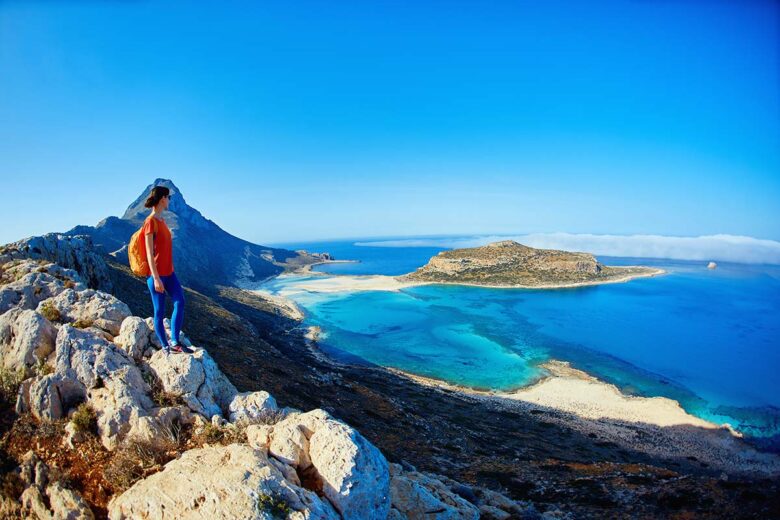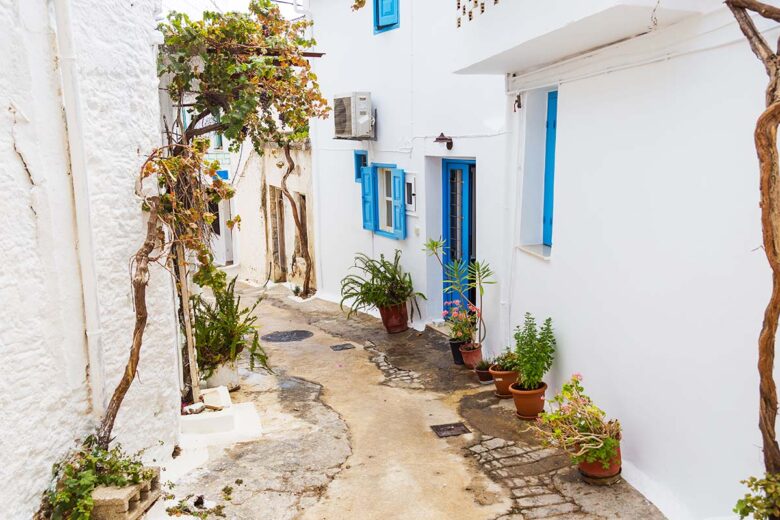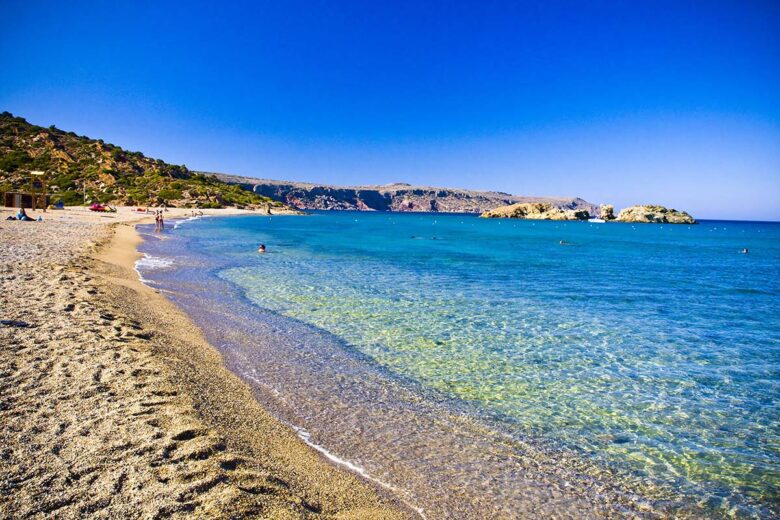
No matter your tastes, there is something for everyone in Crete. From hiking the Samaria Gorge to crossing the threshold of King Minos’s palace, sunbathing on the beaches of Elafonisi to feasting in a traditional seaside taverna, in this post I recommend you 25 of the best things to do in Crete.
There are few places in the world that can match the all-encompassing allure of Crete. The birthplace of Europe’s oldest civilization and fifth-largest island in the Mediterranean, Crete is a dizzying combination of stunning natural beauty and equally rich culture.
History and mythology are tantalizingly interwoven in Crete, with the likes of King Minos, the Minotaur, Icarus and Daedalus, and countless Greek deities making their home on the island.
With its sweeping mountains, paradisiacal beaches, and colorful port cities, Crete offers the visitor a once-in-a-lifetime opportunity to step into another world.
25 Best Things to Do in Crete
1. The Palace Of Knossos

Considered the oldest city in Europe and largest Bronze Age archaeological site in Crete, Knossos is a must-see for visitors of all interests. Located just outside of Crete’s capital Heraklion, the Palace of Knossos is an eye-opener for history and mythology lovers alike.
Constructed approximately 3,000 years ago, the palace was home to King Minos and the labyrinth he commissioned Daedalus to build in order to contain the Minotaur.
While natural and manmade devastations once threatened to keep this archaeological treasure hidden, guests can now explore the palace’s main courtyard, throne room, and sanctuary, as well as journey along part of the Royal Way to view a four-level section of royal apartments.
>>> Skip-the-Line Entry with Guided Walking Tour <<<
2. Heraklion Archaeological Museum
A perfect companion to your visit to Knossos, Heraklion’s Archaeological Museum offers a fascinating glimpse into one of Europe’s oldest civilizations.
Spanning multiple time periods of human history, visitors can walk through the museum’s twenty chronologically ordered galleries and look upon a treasure trove of artifacts ranging from Neolithic tools to Minoan liturgical figurines, weapons, jewelry, and furnishings.
Many of the latter’s pieces were relocated to the museum from nearby Minoan sites, including the Palace of Knossos, and the impressive collection is among the best things to see in Crete.
3. Phaistos Palace And Archaeological Site

Crete’s second-largest palace after Knossos, Phaistos was the mythological home of King Minos’s brother Radamanthus. Set against the striking backdrop of the central plains, Phaistos began as a Neolithic outpost and by 1700 BC was a thriving, dominant city.
Keen-eyed visitors of the Heraklion Archaeological Museum will note that the palace was the source of the mysterious Phaistos Disc, an ancient Minoan emblem that archaeologists have yet to determine the meaning of.
4. Malia’s Minoan Palace
East of Heraklion lies the palace of yet another brother of King Minos, and one of the more hidden gems to see in Crete. While modern-day Malia has been transformed into a busy coastal resort, the palace of Malia, also referred to as Sarpedon’s palace, is Crete’s third-largest Minoan palace.
Abandoned by the end of the second millennium BC, the partially-excavated palace once contained a theater, dual courtyards, royal apartments, ancient artillery units, and an underground crypt-style building where high-ranking lords would meet.
Visitors can tour the open-air ruins and learn firsthand about the palace’s archaeological discovery and restoration.
See also: Where to stay in Crete
5. Arkadi Monastery
The Arkadi Monastery is a beloved national landmark, and among the most moving things to do in Crete. Located southeast of the city of Rethymno, Arkadi was allegedly founded in the 5th century by Byzantine emperor Arcadius, who proudly promoted its wealth and culture during the Ottoman period.
The monastery is famed for being the site of a stand-off between the Greeks and Ottomans during the Cretan Revolt of 1866. Nearly 1,000 Greek citizens, namely women and children, barricaded themselves inside the monastery for three days, and ultimately chose to take their own lives by igniting the gunpowder barrels rather than surrender to the Ottomans.
Today the monastery is admired for its 16th century Venetian architecture and surrounding vineyards and olive groves. November 8 marks the day the siege ended, and is still upheld as a holiday in Arkadi.
6. Kritsa

For those seeking a less conventional but infinitely more authentic excursion, Kritsa is one of the most rewarding places to see in Crete. A small village nestled in the eastern Dikti mountains outside of Agios Nikolaos, Kritsa offers the visitor a unique taste of traditional Cretan life at a much more favorable pace.
Visitors can stroll the picturesque streets, peruse the workshops of local artisans, and even purchase the region’s award-winning olive oil. Photography enthusiasts will especially appreciate the jaw-dropping views, which include a wide stretch of coastline and dramatic Thripti mountain range.
7. Elafonisi Beach
Long regarded as one of the world’s most stunning beaches, Elafonisi is nothing short of paradise.
A nature reserve located on the channel connecting the mainland to the island, Elafonisi’s pink sand beaches, blue lagoons, and postcard views of Crete’s mountain-dotted southwestern coastline continue to draw visitors from all over the globe.
Families and sea-wary persons will appreciate Elafonisi’s calm, shallow waters and large natural pool, making it the ultimate getaway.
Interested in a day trip to Elafonsi Beach? Check this tour!!
8. Balos Lagoon
Balos Lagoon keeps Elafonisi in good company with its equally idyllic imagery and inviting peacefulness. About 37 miles northwest of Chania, Balos can be easily reached by ferry from Kissamos, and is an ideal day trip for island hoppers.
The lagoon is crowned by the Tigani rock formation, and its shallow cerulean waters make for safe and tranquil swimming.
9. Falassarna Beach

Frequently cited as one of Crete’s best beaches, if not in the whole of Europe, Falassarna can be found on the western coast where the Gramvousa Peninsula meets the mainland, and actually consists of five separate beaches bordering the harbor.
As with Elafonisi and Balos, the waters of Falassarna are clear and calm, with the central beach remaining the most popular. The harbor of Falassarna is an additional attraction, as the town was a major maritime influence during the age of antiquity.
Visitors can stroll the newly excavated sections of the harbor quays, which still bear rope marks from their mooring ships, as well as look upon the carved ‘Throne of Phalasarna’ and numerous archaeological discoveries unearthed from a Hellenic merchant’s house.
10. Samaria Gorge
Situated in the White Mountains of Crete’s only national park, the Samaria Gorge is the longest of its kind in Europe. The nearly 10-mile hike takes the traveler through a spectacular landscape, starting on the southern edge of the Omalos plateau and concluding on the south shore of the Libyan Sea.
Colossal ravines, dense forests, and over 450 plant and animal species are just some of the sights you will see on your trek; the abandoned village of Samaria, as well as the endangered kri-kri, Crete’s rock-climbing goat, round out a truly unforgettable experience.
>>> Book your full-Day Samaria Gorge Trekking Excursion from Chania <<<
11. Crete Aquarium
One of Europe’s largest aquariums, the newly renovated ‘Cretaquarium’ is located in the former American Base at Gournes, just outside the city of Heraklion and not far from the Nikos Kazantzakis International Airport.
Boasting 60 different tanks and one hundred viewing points, along with state-of-the-art interactive devices, the aquarium contains approximately 2,500 Mediterranean and tropical organisms.
Visitors are treated to an astounding array of native ecosystems and marine inhabitants ranging from nano-sized sea horses to imposing predator sharks, with guided tours and special learning workshops also available. For children and adults of all ages, this is definitely one of the top things to do in Crete.
12. Spinalonga Island

This small but significant island contains an extraordinary amount of history, and more than earns its spot on the list of recommended things to do in Crete. Positioned as a prominent maritime defense, Spinalonga was seized by the Venetians in 1579, who built their still-standing fortress over the remains of an ancient acropolis.
The island was a shelter for lepers until 1957, and has been featured in a number of popular books and films. Today it is the island’s most popular archaeological site after Knossos, with thousands visiting by ferry from Elounda, Ayios Nikolaos, and Plaka each summer.
13. Visit A Working Olive Oil Farm
Some of the finest olive oil in the world hails from Crete, with each region producing its own subtle and unique variety.
Olive oil is a celebrated mainstay of the Mediterranean diet, and a number of working farms–some dating back generations–welcome visitors to tour the grounds, see how the olives are grown, pressed, and bottled, and of course sample the results.
Additionally, many olive oil farms offer a full dining experience, workshops, and classes for true enthusiasts.
14. Eat At An Authentic Fish Taverna

Tavernas are a staple of Greek dining, and the Cretan fish taverna is a foodie’s dream. Some of the best family-owned fish tavernas are located in Crete’s port towns.
Guests can feast on calamari (fried and grilled), freshly caught fish, sea urchins, shellfish, and mouthwatering seafood pasta dishes. Should you score a seat at a harbor-side taverna, you may very well be treated to seeing your “catch” being hauled in before your eyes!
15. Sample Local Treats
One of the highlights of traveling is tasting new dishes and delicacies, and Crete doesn’t disappoint. Make sure you treat yourself to some of the island’s most popular snacks, including cuttlefish with fennel, sun-dried octopus, and kohli bourbouristi, which consists of fried snails.
Crete also produces an assortment of tasty cheeses that can be found in pastries called kalitsounia, as well as bite-sized dakos, which feature ripe tomatoes, sheep’s cheese, and olive oil. If culinary experiences are your passion, look no further than casual Cretan fare for some of the best things to do in Crete.
16. Diktaean Cave
This sacred ancient Minoan cave has captivated scholars, archaeologists, and lovers of the esoteric for centuries, and ranks high among the most awe-inspiring natural wonders to see in Crete.
According to the Greek poet Hesiod, Zeus’s mother hid him in the cave after giving birth to him, and it’s not uncommon to hear it referred to as “the cave of Zeus.” Located above the village of Psychro, the Diktaean Cave is accessible by two paths, with no shortage of neighboring restaurants and visitor spots to round out the expedition.
17. The Maritime Museum of Crete
Located on the northwest side of the harbor in Chania, the Maritime Museum resides in the entrance of the fortress Firkas, which was built by the Venetians in the 16th century to defend the city.
Visitors can explore Crete’s longstanding maritime history through detailed displays and artifacts, full-scale sailing vessels, and access to one of the centuries-old shipyards, Moro.
18. Savor A Glass Of Raki
For the born-and-bred Cretan, raki is nothing short of a staple. Brewed since the ancient times, raki is traditionally served after meals, and is perfect for sipping as a digestive.
Tours of working distilleries are available, with the typical distilling season falling between October and December. Raki can be enjoyed at pretty much any drinking and dining establishment, and is drunk either plain or flavored with anise, cinnamon, or honey.
19. The Harbor Of Chania
As the second-largest city in Crete, Chania is both vibrant and bustling. While there’s much to appease the diehard shopper and nightlife goer, Chania’s true magic lies in its living history.
The Venetians began construction on Chania’s harbor as early as the 14th century, and it is a must-see attraction for the newly acquainted visitor. The minaret-esque lighthouse, built in the 17th century and later modified in the Egyptian style of the early 19th century, is the jewel of the harbor and Chania’s guiding beacon.
Locals and visitors alike routinely promenade the waterfront, as there is no shortage of shops, restaurants, and historic sites, such as the aforementioned fortress Firkas, to relish.
20. Rethymno Old Town

The historic old town of Rethymno offers a slow-moving and romantic reprieve from the usual tourist hubs in Crete, and boasts some of the island’s most beautiful Turkish and Venetian architecture.
The narrow cobblestone streets are ideal for strolling at your leisure, with the beach just a short walk away. Don’t forget to check out the local shops and enjoy a frappe in one of the cafes, as these seemingly innocuous activities often prove to be the most enjoyable things to do in Crete.
21. Take A Road Trip
It’s no secret that the best way to enjoy Crete is by car; while relatively small and well-served by its public transportation, the island is infinitely more convenient and explorable with a set of wheels.
Daily road trips are one of the best things to do in Crete, with the journey between Chania and Sitia a particularly popular route.
With such a vast and varying landscape and so many sites of interest, you don’t want to miss a thing; with a car at your disposal you can curate a more personal experience, and experience the Crete that was meant for you.
22. Lychnostatis Open Air Museum
Founded between 1986 and 1992 by the writer, doctor, and collector Georgios Makrakis, the Open Air Museum at Lychnostatis was constructed using raw materials and traditional building methods only, and is dedicated to the archival and celebration of Crete’s heritage.
The museum covers all aspects of Cretan life, from traditional trades and occupations such as weaving, pottery, olive oil pressing, and raki distilling to post-industrial innovations.
Visitors can additionally explore both modern and traditional Cretan art and architecture, watch a performance at the site’s 250-seat auditorium, or sip a glass of local wine in the surrounding gardens.
23. Vai Beach

Located on the northeastern side of Crete in the Lassithi region, Vai beach is well known for its 5,000 surrounding palm trees, which make up the largest palm tree forest in Europe.
The beach’s powder-fine sand, crystalline waters, and soothingly tropical setting are ideal for families and those who prefer the more serene spots to see in Crete. .
While there is a modest canteen for purchasing drinks and snacks, there’s hardly a better occasion for packing a Cretan-inspired picnic.
24. Make A Pilgrimage To The Holy Trinity Monastery
The Agia Triada monastery, whose name translates to “holy trinity,” is a working Greek Orthodox monastery and museum, as well as wine and olive oil producer.
Built in the 17th century by two Venetian brother monks, the monastery’s Byzantine influences and expansive library marked it as one of the most important places to see in Crete.
While many of the monastery’s most treasured manuscripts and documents were destroyed by the Turks in 1821, the site eventually reestablished itself after the Greek Revolution, and would go on to contribute to much of Crete’s education, local economy, and ecclesiastical life.
Today guests can tour the grounds and inner churches, visit the museum, and purchase the monastery’s own wine and olive oil products.
25. Indulge In A Wine Tasting Tour
Raki isn’t the Cretan’s only drink speciality, and wine tasting is one of the most delicious things to do in Crete. While the whole of the island contains countless working vineyards, approximately 70% of Crete-produced wine comes from Peza, located in a sub-region of Heraklion.
Winery tours are available year-round, where guests can learn about the history and process of Cretan wine-making, as well as the types of grapes used. For those wishing to taking a case (or two) of wine back home, many of the more commercial wineries are happy to offer shipping service..